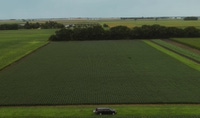Media
How smart farming practices can reduce up to 30% of greenhouse gas emissions
Through BASF’s Global Carbon Farming Program, launched in 2021, farmers can expand climate-smart farming practices that capture carbon from the atmosphere and store it in the soil. This can help reduce the impact of climate change and the amount of greenhouse gas emissions emitted in farming by up to 30%.

Today, agriculture is responsible for close to 17% of global carbon dioxide (CO2) emissions, which is why implementing carbon-efficient practices can significantly contribute to fighting climate change. Lowering CO2 emissions involves every player in the agricultural sphere, but especially farmers, since they are involved in production and can sequester carbon in the soil.
For the love of farming, the biggest job on Earth. That is the key motivator behind BASF’s Agricultural Solutions initiatives, including the Global Carbon Farming Program. Learn more about this program and the great results obtained from the 2023 trials in North America, next.
What is carbon sequestration?
Carbon sequestration in soil is a process that can help mitigate climate change, reduce the amount of carbon dioxide in the atmosphere, and improve soil health and crop yields.
Essentially, plants capture the CO2 through photosynthesis and later transfer it to the soil through the roots, litter and other types of biomass, in the form of organic matter. During the decomposition of the matter, microbes turn this material into stable organic carbon compounds that can be stored over time in the soil.
The way the soil is managed affects its ability to store carbon, which is why implementing climate-smart agricultural practices is so important. Through BASF’s Global Carbon Farming Program, farmers can learn and apply sustainable agricultural practices, promoting the best use of BASF’s portfolio and reducing the amount of greenhouse gases in the atmosphere, including carbon dioxide (CO2). These practices not only ensure food security and income for farmers but also help build resilience, which is the soil’s ability to buffer the impact of weather extremes on crop yield. Specific practices can be adapted to the local soil and environmental conditions.
They can also generate carbon credits from internationally recognized certifiers, potentially providing farmers involved in sequestration and reduced CO2 emissions with additional revenue streams.
The goal: a 30% carbon intensity reduction per ton of crop by 2030
Since its beginning in 2021, the Global Carbon Farming Program has conducted a series of field trials across multiple seasons and locations with a focus on five specific crops: soy, canola, corn, wheat and rice.
The report's most recent results were published in 2024. Several of these trials were conducted in the United States and Canada, specifically with soy, canola and corn. The purpose of the trials is to apply the best innovations toward achieving a specific sustainability target: to reduce the carbon intensity of key crops* in North America by 30% per ton grown by 2030. During these trials, BASF experts tested suitable alternatives to standard agricultural practices to reduce the carbon intensity as calculated using BASF’s Life Cycle Assessment calculator AgBalance .

Soy
Soy production practices in the United States are different from those in Brazil, where tilling is much more popular. When the Illinois trial started in 2022, the carbon intensity of the standard management was 374kg CO2e** per ton of crop, which consisted of conventional tillage in wide rows of 30 inches.
That same year, no-till as also implemented along with advanced seed treatments, foliar fungicides, and planting in narrow rows (15 inches). This change increased yield by 6% and reduced carbon intensity by 5%.
Corn
In 2023, the Illinois trial consisted of corn where the estimated intensity of greenhouse gas (GHGi) emissions of the standard management was 167kg CO2e per ton of crop. In the fall of 2022, as part of the soy/corn rotation, the team planted cereal rye as a cover crop and maintained no-till, while using a urease inhibitor to improve nitrogen use efficiency.
After terminating the rye in spring 2023, they planted corn and incorporated a split nitrogen application treatment to further improve nitrogen use efficiency. There was a mild decrease in yield, which is expected whenever there are significant changes in farm operations, combined with the drought conditions that took place early in the season.
To buffer this the impact, BASF experts set up a specific nitrogen plan with rates based on soil testing, which led to carbon intensity reductions of between 6% and 12%.
Canola
The canola trial was held in Saskatchewan, Canada, where the carbon intensity ranged between 773 and 1600 kg CO2e per ton of crop. By implementing climate-smart approaches and the latest technology, BASF experts achieved a 21% reduction in carbon intensity in 2022 and between 20% and 63% in 2023.
This was a result of the remarkably high yields accomplished by implementing BASF advanced genetics, weed control and herbicides, as well as an insecticide seed treatment to control flea beetles, including a nitrogen stabilizer, and maintaining zero-till. However, yield across all treatments was negatively affected by drought.
Challenges and next steps
The challenges identified by BASF experts are the same for all three crops: weather conditions, pests and diseases, all of which can negatively impact yield. Canola in Saskatchewan, for instance, has been heavily impacted by dry years.
There is no single approach to climate-smart agriculture that successfully reduces emissions. The crop and local conditions can significantly impact the extent of CO2e emissions. However, as some of the trials have already shown, it is possible to achieve this.
These ongoing trials will continue to advance our knowledge and unlock the right combination of practices to achieve meaningful carbon intensity reductions for these key crops while also demonstrating the agronomic and soil health improvements associated with climate-smart farming practices.
“BASF’s carbon farming trials in North America demonstrate what farmers are experiencing on their own farms – implementing climate-smart practices can improve soil organic carbon thereby resulting in soil health and crop resilience to weather extremes. While the yield increases may not be immediate, the reduced carbon intensity of the crop could mean an added value for certain carbon farming opportunities,” explains Chad Asmus, Sustainability Market Development Manager for Agricultural Solutions, North America.
* The key crops in North America are wheat, soy, canola, and corn.
** CO2e is the standardized unit to report on the effect of different greenhouse gases (i.e., CO2, CH4, N2O, SF6, NF3) on climate and it considers the potency of each gas with respect to CO2.
Published on May 20, 2025, by Mariana Licio.
For media inquiries or to repurpose this article, please contact Lisa Brown.